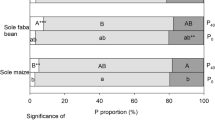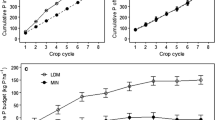Abstract
Increases in P fertiliser use in Australian grain production systems over the past decades have not necessarily coincided with improved nutrient-use efficiency by crops because only a small proportion of applied P has been directly used by crops, leaving large amounts of the P in soil. Information on the transformation of applied P and the residual effectiveness of P fertiliser in growers’ paddocks under their crop rotations in a wide range of soil types may help to develop improved management practises for P fertilisers. The present study examined the size and changes of P pools in soils in the major regions used for grain production across northern Victoria. Soil samples were collected from 43 sites representing all the major soil types. In addition, samples were collected from adjacent ‘reference’ areas across fence-lines where remnant native vegetation was present to examine long-term changes in soil fertility as a result of cropping. Highly positive P balance in 27 growers’ paddocks indicates potentially high rates of P fertilization in excess of that exported/lost from these paddocks. The accumulated P was transformed into both labile and non-labile pools depending on the general chemical–physical properties of a particular soil. In particular, in soils with a sandy texture and low oxalate-extractable Al and Fe such as the sandy Calcarosols, the residual P fertilizer was preferentially transformed into labile and moderately labile pools. These P fractions can be available for subsequent crops. In contrast, a large proportion of P fertilizer applied to other soil types has been transformed into the non-labile P pools where crops have difficulty in accessing. It is suggested that P application rates should be reduced to avoid the loss of P through sorption/precipitation, leaching or run-off while still meet crop demand.



Similar content being viewed by others
References
Angus JF (2001) Nitrogen supply and demand in Australian agriculture. Aust J Exp Agric 41:277–288
Angus JF, Bowden JW, Keating BA (1993) Modelling nutrient responses in the field. Plant Soil 155:57–66
Bertrand I, Holloway RE, Armstrong RD, McLaughlin MJ (2003) Chemical characteristics of phosphorus in alkaline soils from southern Australia. Aust J Soil Res 41:61–76
Blake L, Mercik S, Koerschen M, Moskal S, Poulton PR, Goulding KWT, Weigel A, Powlson DS (2000) Phosphorus content in soil, uptake by plants and balance in three European long-term field experiments. Nutr Cycl Agroecosyst 56:263–275
Bolan NS (1991) A critical review on the effect of mycorrhizal fungi on the uptake of phosphorus by plants. Plant Soil 134:189–207
Bolan NS, Adriano DC, Curtin D (2003) Soil acidification and liming interactions with nutrient and heavy metal transformation and bioavailability. Adv Agron 78:216–272
Bolland MDA, Gilkes RJ (1998) The relative effectiveness of superphosphate and rock phosphate for soils where vertical and lateral leaching of phosphate occurs. Nutr Cycl Agroecosyst 51:139–153
Buhler S, Oberson A, Rao IM, Friesen DK, Frossard E (2002) Sequential phosphorus extraction of a 33P-labeled Oxisol under contrasting agricultural systems. Soil Sci Soc Am J 66:868–877
Bunemann EK, Steinebrunner F, Smithson PC, Frossard E, Oberson A (2004) Phosphorus dynamics in a highly weathered soil as revealed by isotopic labeling techniques. Soil Sci Soc Am J 68:1645–1655
Dalal RC, Chan KY (2001) Soil organic matter in rainfed cropping systems of the Australian cereal belt. Aust J Soil Res 39:435–464
Dalal RC, Mayer RJ (1986a) Long-term trends in fertility of soils under continuous cultivation and cereal cropping in southern Queensland. I. Overall changes in soil properties and trends in winter cereal yields. Aust J Soil Res 24:265–279
Dalal RC, Mayer RJ (1986b) Long-term trends in fertility of soils under continuous cultivation and cereal cropping in southern Queensland. II. Total organic carbon and its rate of loss from the soil profile. Aust J Soil Res 24:281–292
Farmer CV, Russell JD, Smith BFL (1983) Extraction of inorganic forms of translocated Al, Fe and Si in a podzol Bs horizon. J Soil Sci 34:571–576
Guo F, Yost RS, Hue NV, Evensen CI, Silva JA (2000) Changes in phosphorus fractions in soils under intensive plant growth. Soil Sci Soc Am J 64:1681–1689
Hedley MJ, McLaughlin MJ (2005) Reactions of phosphate fertilizers and by-products in soils. In: Sims JT, Sharply AN (eds) Phosphorus: agriculture and the environment. American Society of Agronomy, Inc./Crop Science Society of American, Inc./Soil Science Society of American, Inc., Madision, pp 181–252
Hedley MJ, Stewart JWB, Chauhan BS (1982) Changes in the inorganic and organic phosphorus fractions induced by cultivation practices and by laboratory incubation. Soil Sci Soc Am J 46:970–976
Hingston FJ, Atkinson RJ, Posner AM, Quirk JP (1967) Specific adsorption of anions. Nature 215:1459–1461
Holford ICR (1997) Soil phosphorus: its measurement, and its uptake by plants. Aust J Soil Res 35:227–239
Isbell RF (1996) The Australian soil classification. CSIRO Publishing, Melbourne
Krishna KR (2002) Soil phosphorus, its transformations and their relevance to crop productivity. In: Krishna KR (ed) Soil fertility, crop production. Science publishers, Inc., Enfield/Plymouth, pp 109–140
Kucey RMN, Janzen HH, Leggett ME (1989) Microbially mediated increases in plant-available phosphorus. Adv Agron 42:199–228
Leeper G, Uren NC (1993) Soil science: an introduction. Melbourne University press, Melbourne
Mathers NJ, Nash DM, Gangaiya P (2007) Nitrogen and phosphorus exports from high rainfall zone cropping in Australia: issues and opportunities for research. J Environ Qual 36:1551–1562
McLaughlin MJ, Ryden JC, Syers JK (1981) Sorption of inorganic phosphate by iron and aluminium containing components. J Soil Sci 32:365–377
McLaughlin MJ, Alston AM, Martin JK (1988) Phosphorus cycling in wheat-pasture rotations. II. The role of the microbial biomass in phosphorus cycling. Aust J Soil Res 26:333–342
Murphy J, Riley JP (1962) A modified single solution method for the determination of phosphate in natural waters. Anal Chim Acta 27:31–36
Newton PJ, Armstrong RD, Vu DT, Dart L, Norng S (2008) Bioassay of nutrient supply capacity of soils under different crop management regimes and fence line conditions across northern Victoria (NMI GRDC Project 075441 report)
Oberson A, Friesen DK, Rao IM, Buhler S, Frossard E (2001) Phosphorus transformations in an Oxisol under contrasting land-use systems: the role of microbial biomass. Plant Soil 237:197–210
Ozanne PG (1980) Phosphate nutrient of plants—a general treatise. In: Khasawneh FE, Sample EC, Kamprath EJ (eds) The role of phosphorus in agriculture. American Society of Agronomy, Madison, pp 559–590
Perrott KW, Maher FM, Thorrold BS (1989) Accumulation of phosphorus fractions in yellow-brown pumice soils with development. NZ J Agric Res 32:53–62
Pheav S, Bell RW, White PF, Kirk GJD (2003) Fate of applied fertilizer phosphorus in a highly weathered sandy soil under lowland rice cropping, and its residual effect. Field Crop Res 81:1–16
Rabobank (2007) Agricultural fertiliser prices set to remain high on back of upsurge in global demand—industry report. Available at: http://www.rabobank.com.au/inside_rabobank/news/media_releases/media_release_291107.asp
Rayment GE, Higginson FR (1992) Australian laboratory handbook of soil and water chemical methods. Inkata Press, Melbourne-Sydney
Reuter DJ, Edward DG, Wilhelm NS (1997) Temperate and tropical crops. In: Reuter DJ, Robinson JB (eds) Plant analysis: an interpretation manual. CSIRO Publishing: Collingwood, Victoria, pp 81–279
Richardson AE (1994) Soil microorganisms and phosphorus availability. In: Pankhurst CE, Doube BM, Gupta VVSR, Grace PR (eds) Management of the soil biota in sustainable farming systems pp. 50–62. CSIRO, Melbourne, pp 50–62
Richardson AE (2001) Prospects for using soil microorganisms to improve the accquisition of phosphorus by plants. Aust J Plant Physiol 28:897–906
Samadi A, Gilkes RJ (1998) Forms of phosphorus in virgin and fertilised calcareous soils of Western Australia. Aust J Soil Res 36:585–601
Sharpley AN, McDowell R, Kleinman PJA (2001) Phosphorus loss from land to water: integrating agricultural and environmental management. Plant Soil 237:287–307
Slattery W, Fay A (1999) Identifying key soil indicators for sustained agricultural production: a map Book for 117 Benchmark Sites (established 1995–1997). Agriculture Victoria, Rutherglen
Syers JK, Johnston AE, Curtin D (2008) Efficiency of soil and fertilizer phosphorus use: reconciling changing concepts of soil phosphorus behaviour with agronomic information. Food and Agriculture Organization of the United Nations. FAO Fertilizer and Plant Nutrition Bulletin, 18
Tan KH (1998) Principles of soil chemistry. Marcel Dekker, Inc, New York
Tiessen H, Moir JO (1993) Characterisation of available P by sequential extraction. In: Carter MR (ed) Soil sampling and methods of analysis. Lewis Publishers, London, pp 75–86
Tisdall JM, Oades JM (1982) Organic matter and water-stable aggregates in soils. J Soil Sci 33:141–163
Vu DT (2004) Phosphorus sorption in acid sulphate soils of the Coode Island Silt, Yarra Delta, Central Victoria. Master thesis, La Trobe University, Melbourne, Australia
Vu DT, Tang C, Armstrong RD (2008) Changes and availability of P fractions following 65 years of P application to a calcareous soil in a Mediterranean climate. Plant Soil 304:21–33
Vu DT, Tang C, Armstrong RD (2009) Tillage system affects phosphorus form and distribution in three contrasting Victorian soils. Aust J Soil Res 47:33–45
Vu DT, Tang C, Armstrong RD (2010) Transformations and availability of phosphorus in three contrasting soil types from native and farming systems: a study using fractionation and isotopic labeling techniques. J Soil Sedi 10:18–29
Wang X, Lester DW, Guppy CN, Lockwood PV, Tang C (2007) Changes in phosphorus fractions at various soil depths following long-term P fertiliser application on a Black Vertosol from south-eastern Queensland. Aust J Soil Res 45:524–532
Acknowledgments
We thank Ms Lauren Dart (The University of Melbourne) for her assistance to sample the soils and analysis of soil organic C and total N. We acknowledge the Victorian Department of Primary Industries for providing access to the long-term sites and the Grains Research and Development Corporation for financial support through the Nutrient Management Initiative project UM00023. We would also like to acknowledge the co-operation of the different growers and their families for allowing access to their paddocks and management records.
Author information
Authors and Affiliations
Corresponding author
Rights and permissions
About this article
Cite this article
Vu, D.T., Armstrong, R.D., Newton, P.J. et al. Long-term changes in phosphorus fractions in growers’ paddocks in the northern Victorian grain belt. Nutr Cycl Agroecosyst 89, 351–362 (2011). https://doi.org/10.1007/s10705-010-9400-6
Received:
Accepted:
Published:
Issue Date:
DOI: https://doi.org/10.1007/s10705-010-9400-6




